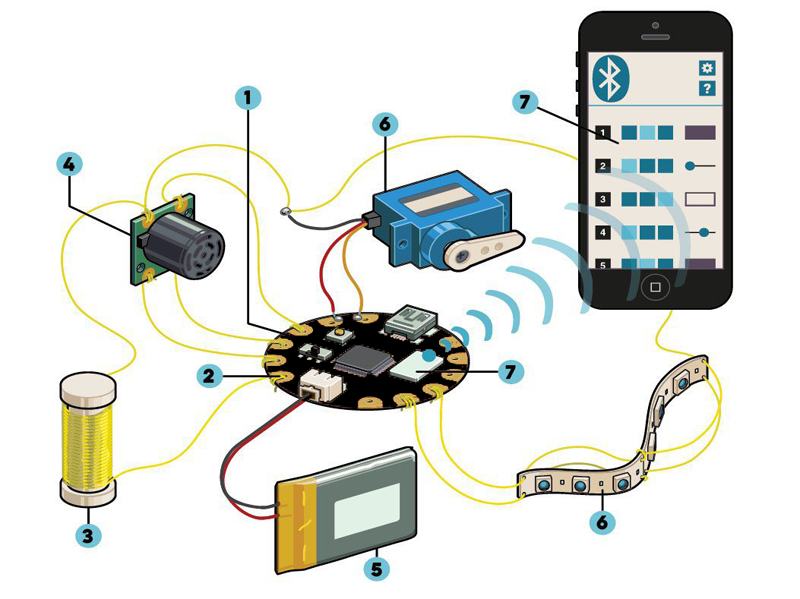An Illustrated Guide to Wearable Components
Bodies aren’t static, they don’t have straight lines, and after a while they tend to get dirty. So wearable systems embedded in garments and accessories have to be robust, flexible, and, ideally, washable (or at least removable). Here’s a look under the hood — or hoodie, as it were — at the main components of wearable devices.
 Illustration by Rob Nance
Illustration by Rob Nance
1. CONTROL
Wearable-specific microcontrollers are small, so as to be comfortable and discrete. On the other hand, the distinctive shapes and colors can function as a decorative element. Several of the boards available are hand-washable (minus the power source). Read the documentation carefully. See Cheapduino, Beetle and Bluno Beetle.
2. INPUT/OUTPUT
In place of pins, these boards have metal eyelets which you can loop conductive thread through to sew soft circuit connections. Some boards also have snaps — or eyelets large enough to solder on snaps — for easy removal.
3. CONDUCTIVE TEXTILES
A material containing metals, such as silver or stainless steel, through which an electrical current can flow is said to be conductive. Wearable systems can make use of these materials in a variety of ways, such as:
Thread for making circuits
Fabric for capacitive touch sensors
Hook-and-loop for switches
4. SENSORS
Sensors gather information about the environment, the user, or both. Examples of the former include light, temperature, motion (ACC), and location (GPS). Examples of the latter include heart rate (ECG), brain waves (EEG), and muscle tension (EMG). A few wearable microcontrollers have basic sensors onboard. Other manufacturers offer a range of external sensor modules that connect to the main board.
5. POWER
When scoping out a wearable design one of the first things to consider is the power requirement. Do you just want to illuminate a few LEDs, or do you want to run a servomotor? Boards with an integrated holder for a lithium coin battery are nice for low-power projects that need to be self-contained. However boards with a standard JST connector (with or without a circuit to charge LiPo batteries) are more versatile.
6. ACTUATORS
One generic way to describe a wearable system is: In response to X, where X is the input from a sensor, Y happens. Actuators such as LEDs, buzzers or speakers, and servomotors are what make things happen.
7. NETWORKING
To communicate with smart devices, the internet, or other wearable systems, you need wireless connectivity. In addition to wi-fi and Bluetooth, wearable-friendly options include:
BLE, which has lower power consumptionthan classic Bluetooth, a range of 50m, and a data transmission rate up to 1 Mbps
NFC, a radio frequency field with a range ofapproximately 20cm and data transmission rate up to about 400 Kbps






 Home
Home
 Category
Category
 Shopping Cart
Shopping Cart
 Me
Me